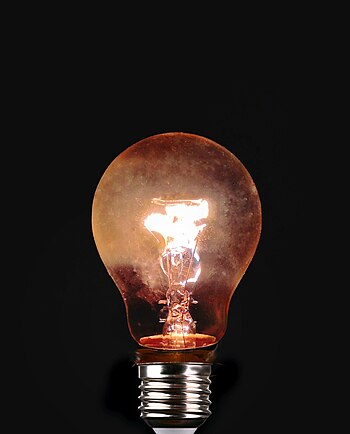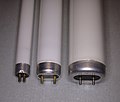Light bulb: Difference between revisions
Pat Palmer (talk | contribs) |
Pat Palmer (talk | contribs) |
||
| Line 20: | Line 20: | ||
== Conversion of flourescent tubes to LED== | == Conversion of flourescent tubes to LED== | ||
Fluorescent tube light bulbs have two dimensions; diameter and length. The type of tube is determined by its diameter, with T2 (7mm), T4 (12mm), T5 (15mm), T8 (25mm), T12 (38mm) all available in multiple lengths and wattages. In industrial settings, | Fluorescent tube light bulbs have two dimensions; diameter and length. The type of tube is determined by its diameter, with T2 (7mm), T4 (12mm), T5 (15mm), T8 (25mm), T12 (38mm) all available in multiple lengths and wattages. In industrial settings, four-foot T12 flourescent lamps are very common. | ||
The fixtures of linear flourescent tube light bulbs, which require a ballast to modulate electrical current and to start, can be rewired to use no ballast and instead use LED tube-shaped bulbs at a fraction of operational cost, with bulbs lasting much longer. Elimination of the need for the ballast also makes them much more reliable, as ballasts were a typical point of failure resulting in flickering lights, a humming sound, or lights which would not turn on at all. | The fixtures of linear flourescent tube light bulbs, which require a ballast to modulate electrical current and to start, can be rewired to use no ballast and instead use LED tube-shaped bulbs at a fraction of operational cost, with bulbs lasting much longer. Elimination of the need for the ballast also makes them much more reliable, as ballasts were a typical point of failure resulting in flickering lights, a humming sound, or lights which would not turn on at all. | ||
Revision as of 05:48, 9 April 2023
A light bulb is a sealed body of glass (a bulb or globe) encasing a source of illumination.
The original "incandescent" bulb
The first (and for decades, the only) type of light bulb was the incandescent lamp. Its globe contains two electrical points of contact, a filament (a coil made of tungsten that glows brightly when current is applied), and an amount of an inert gas. The invention of the incandescent light bulb is usually credited to Thomas Alva Edison, who filed for a patent dated January 27, 1880 (patent #223898(US)). However multiple inventors and scientists at the time were also working to produce an incandescent bulb. Englishman Sir Joseph Swan produced an electric bulb in 1878. In 1880, Edison and his engineering staff produced a bulb very similar to the one we have today, using a bamboo fiber filament lamp that lasted between 1200-1500 hours and was rated at 16 watts.
Type of modern light bulbs
Different types of light bulbs exist today as a result of lighting requirements and energy demands.
- Compact Fluorescent Lights (CFLs) are smaller versions of fluorescent lights that are designed to fit into regular lamp sockets. The advantage of CFLs are that they produce mostly visible light but with very little power consumption. However, CFLs contain mercury, a toxic heavy metal, so they should be recycled and not added to landfills.
- LEDs, or Light Emitting Diodes, are small, compact sources of light usually integrated into electronics, although they have become more popular in consumer lighting because of the relatively low production cost, low energy demands, and high light output.
- Halogen light bulbs were invented earlier than CFLs, and are a substitute for regular lighting applications, but the primary disadvantages are that the heat produced by a halogen bulb is much greater than that of an incandescent and has been the cause of some fires as a result. Halogen systems also require a special type of socket. Some halogen systems may require an integrated step-down transformer which doesn't necessarily decrease the amount of power consumed, but allows for adjustment to be made from a "dimmer system" in order to control the amount of light produced by each bulb.
U.S. transition to LED bulbs
In the United States, incandescent, halogen and compact flourescent light bulbs will stop being sold, and will be banned from being sold by the U.S. Department of Energy, effective as of August 2023. LED lights last twenty-five times longer than incandescent ones and require only a fraction of the energy. LED bulbs with a Kelvin rating of 2700 have a warm light akin to older incandescent bulbs. But many cheaper LED bulbs have a Kelvin rating of 5000+, which provides a garish blue-white light (more akin to daylight) that people may not enjoy, especially at night. People using mechanical dimmers with incandescent bulbs may also need to replace the dimmer with ones rated to work with LED bulbs.
Compact flourescent bulbs are included in the ban because of their toxic mercury that can be released into the home if broken and should not be placed in landfills upon disposal.
Conversion of flourescent tubes to LED
Fluorescent tube light bulbs have two dimensions; diameter and length. The type of tube is determined by its diameter, with T2 (7mm), T4 (12mm), T5 (15mm), T8 (25mm), T12 (38mm) all available in multiple lengths and wattages. In industrial settings, four-foot T12 flourescent lamps are very common.
The fixtures of linear flourescent tube light bulbs, which require a ballast to modulate electrical current and to start, can be rewired to use no ballast and instead use LED tube-shaped bulbs at a fraction of operational cost, with bulbs lasting much longer. Elimination of the need for the ballast also makes them much more reliable, as ballasts were a typical point of failure resulting in flickering lights, a humming sound, or lights which would not turn on at all.



